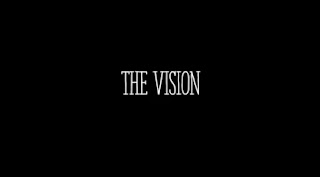The next film I decided to look at was The Vision. The film starts off with very dark lighting, much darker than the previous film I viewed. The warm saturation in combination with lighting adds a suspenseful feeling that is very typical of mystery films. The close ups of different objects in the room builds anticipation for the viewer. It makes me sit on the edge of my seat to see where the story will go. Just like the other film, The Vision ulitizes closer shots to develop the mystery of plot. Another big mystery aspect that is found in this film is its use of sound. Early on, there is a combination of ambient sounds and eerie music that combine to further keep me on my toes. In fact, the lighting sounds even caught me off guard and slightly frightened me.
After being introduced to the first setting, a bedroom, and seemingly the main protagonist, the use of dialogue and props furthers the uncanny yet curious feeling in the viewer. The distressed pleas for help from the walkie talkie add onto the mystery of the film and introduces the conflict. It poses a series of questions in the viewer's mind. Who is Mike? What’s happening to him?
Towards the middle of the film, an establishing shot introduces a new setting of a forest. The last film also utilized a forest. Multiple mystery films seem to use forest, as they typically are surrounded by feelings of unknown and mystery. Diegetic sounds of thunder continue through the scenes that add to the unsettling location. Over the shoulder shots are used as the protagonist goes to approach a house in the forest. The previous film also utilized this shot, which is relatively common in mystery films. The lack of access to the full view of the protagonist builds drama and suspense.
As the film moves towards the end, the lighting gets even darker and the saturation does down, creating this dull feeling. The cutaway from the speeding car to the protagonist watching it approach builds up the suspense and leaves the viewer questioning if the car will truly hit his friend. The vague dialogue of his friend and his emotionless face builds confusion, which many mystery films like Glass Onion use. The film ends by cutting to the protagonist waking up from a dream and the earlier scenes repeating.
I really enjoyed the use of camera angles and editing techniques in the films. The close ups build a suspenseful feeling and keeps the viewer interested by not giving away too much of the plot. The editing techniques also help create a sense of suspenseful by drawing out the scenes. The lighting and use of sound also played a huge role in building the suspense. This film has provided a lot of inspiration for the film my group and I will be creating.

Comments
Post a Comment